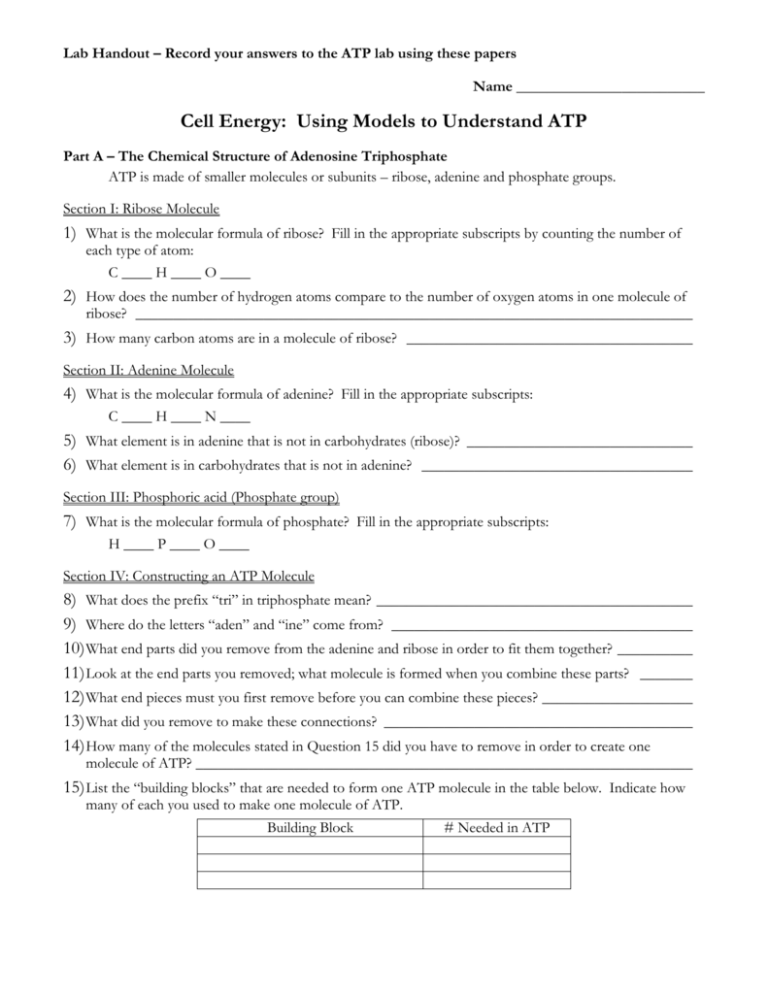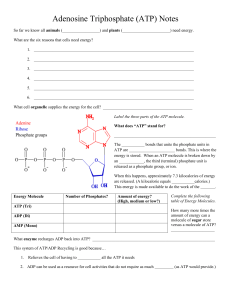Handout
advertisement

Lab Handout – Record your answers to the ATP lab using these papers Name _________________________ Cell Energy: Using Models to Understand ATP Part A – The Chemical Structure of Adenosine Triphosphate ATP is made of smaller molecules or subunits – ribose, adenine and phosphate groups. Section I: Ribose Molecule 1) What is the molecular formula of ribose? Fill in the appropriate subscripts by counting the number of each type of atom: C ____ H ____ O ____ 2) How does the number of hydrogen atoms compare to the number of oxygen atoms in one molecule of ribose? __________________________________________________________________________ 3) How many carbon atoms are in a molecule of ribose? ______________________________________ Section II: Adenine Molecule 4) What is the molecular formula of adenine? Fill in the appropriate subscripts: C ____ H ____ N ____ 5) What element is in adenine that is not in carbohydrates (ribose)? ______________________________ 6) What element is in carbohydrates that is not in adenine? ____________________________________ Section III: Phosphoric acid (Phosphate group) 7) What is the molecular formula of phosphate? Fill in the appropriate subscripts: H ____ P ____ O ____ Section IV: Constructing an ATP Molecule 8) What does the prefix “tri” in triphosphate mean? __________________________________________ 9) Where do the letters “aden” and “ine” come from? ________________________________________ 10) What end parts did you remove from the adenine and ribose in order to fit them together? __________ 11) Look at the end parts you removed; what molecule is formed when you combine these parts? _______ 12) What end pieces must you first remove before you can combine these pieces? ____________________ 13) What did you remove to make these connections? _________________________________________ 14) How many of the molecules stated in Question 15 did you have to remove in order to create one molecule of ATP? __________________________________________________________________ 15) List the “building blocks” that are needed to form one ATP molecule in the table below. Indicate how many of each you used to make one molecule of ATP. Building Block # Needed in ATP 16) Look back at the introduction; what substance is needed in order for these parts to combine? ________ Part B – Releasing Energy from ATP as it Changes to ADP 17) How many phosphate groups are still attached to the original molecule? ________________________ 18) Look at this molecule to determine what the prefix “di” means. _______________________________ 19) List the “building blocks” that are needed to form one ADP molecule. Indicate how many of each you used to make your one molecule of ADP. Building Block # Needed in ADP 20) Explain how one ATP molecule is changed into one ADP molecule. ___________________________ 21) Look back at the introduction; what substance is released when ADP is formed? __________________ For example, this change may be written as follows: becomes ATP ADP + Phosphate group + E 22) What might the letter “E” be an abbreviation for in the above equation? ________________________ Part C – Changing ADP to ATP ADP + Phosphate group + E becomes ATP 23) What might the letter “E” be an abbreviation for in the above equation? ________________________ Part D – An Energy Source for Converting ADP to ATP 24) Count and record the number of bonds in: a. one molecule of glucose __________________________________________________________ b. two molecules of pyruvic acid _____________________________________________________ NOTE: Be sure to count double lines as two bonds and all other lines as one bond. 25) Is the total number of bonds in one glucose molecule the same as the total number of bonds in two pyruvic acid molecules? _____________________________________________________________ 26) Is the amount of energy in one glucose molecule the same as the energy in two pyruvic acid molecules? _______________________________________________________________________ 27) Look back at the introduction. How is some of this extra energy used by a cell? __________________ ___________________________________________________________________________________ Data Analysis/Conclusion 28) List the name and number of each building block used in ATP and ADP. Fill in the table to the right. Building Block # Needed in ATP # Needed in ADP 29) Compared to ADP, does ATP have: a. b. c. d. a greater, fewer or equal number of phosphates? _______________________________________ a greater, fewer or equal number of ribose molecules? ___________________________________ a greater, fewer or equal number of adenine molecules? __________________________________ more, less or equal amount of energy stored in its bonds? ________________________________ 30) Your muscles require energy to move your body. What food directly supplies your muscles with this energy? __________________________________________________________________________ 31) What process directly supplies your body with the energy it needs to change ADP back to ATP? ________________________________________________________________________________ 32) What does the energy released from ATP get used for in a cell? ______________________ ___________________________________________________________________________________ ___________________________________________________________________________________ 33) Changes from ATP to ADP and back again are often said to occur in a cycle as shown below. Energy is both given off and used for work. Energy is also stored during cellular respiration. Complete the diagram below by writing the phrases “energy given off” and “energy stored from respiration” in the correct spaces. ATP ADP + Phosphate Group





